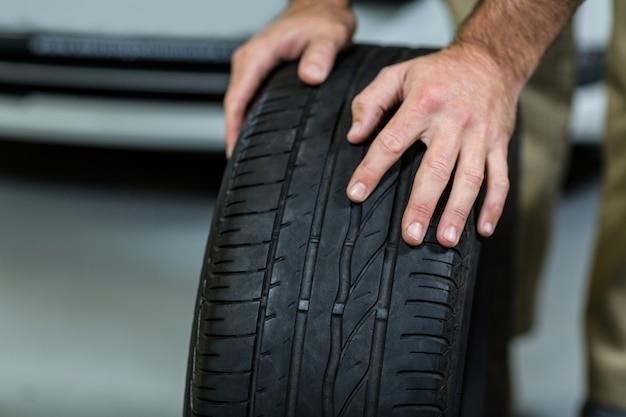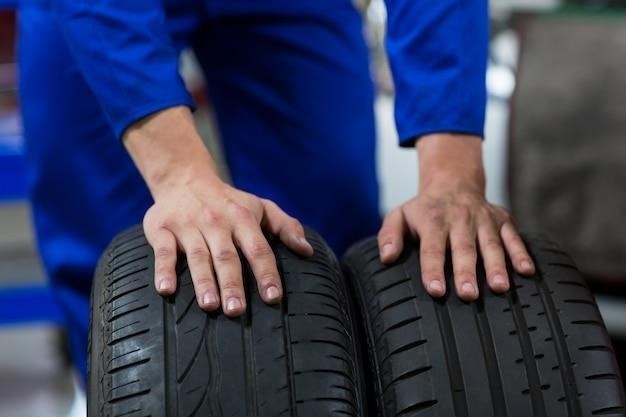Understanding Tire Fitment Basics
Understanding tire fitment is crucial for safety and performance․ Proper fitment ensures optimal handling, braking, and speedometer accuracy․ Incorrect fitment can lead to issues such as rubbing, premature wear, and even accidents․ A tire fitment guide helps determine compatibility between tires and rims, considering factors such as width, diameter, and aspect ratio․ This ensures a safe and effective vehicle setup․
Tire Size and Rim Width Compatibility
Tire size and rim width compatibility is a critical aspect of tire fitment․ The tire’s width, expressed in millimeters, should ideally fall within the range recommended by the tire manufacturer for a given rim width․ Using a tire that’s too narrow for the rim can lead to instability and poor handling, while a tire that’s too wide might cause the tire sidewalls to bulge excessively, increasing the risk of damage and compromising handling․ Conversely, using a rim that’s too narrow or wide for the tire can negatively impact tire performance and safety․ Consult the tire sidewall markings and manufacturer’s guidelines to ensure compatibility․ Online resources and fitment calculators can help determine if a particular tire-rim combination is suitable for your vehicle․
Aspect Ratio and Tire Profile
The aspect ratio, a crucial element in tire fitment, represents the tire’s sidewall height as a percentage of its width․ For example, a tire with an aspect ratio of 75 means its sidewall height is 75% of its width․ This ratio significantly impacts the tire’s overall diameter, ride comfort, and handling characteristics․ A higher aspect ratio results in a taller, more flexible sidewall, offering a more comfortable ride but potentially less responsive handling․ Conversely, a lower aspect ratio yields a shorter, stiffer sidewall, enhancing handling precision but potentially sacrificing ride comfort․ Understanding the aspect ratio is essential when selecting replacement tires, as altering this value can affect speedometer calibration and overall vehicle performance․ Choosing a compatible aspect ratio is key for maintaining the intended vehicle dynamics․

Key Wheel Fitment Specifications
Precise wheel fitment is vital for safe and optimal vehicle operation․ Key specifications include wheel offset, determining wheel position relative to the hub mounting surface, and PCD (Pitch Circle Diameter), defining the bolt pattern․ These factors directly influence handling, clearance, and overall vehicle performance․
Wheel Offset and its Impact
Wheel offset, a crucial specification in tire fitment, significantly impacts a vehicle’s handling, appearance, and overall safety․ It’s defined as the distance between the wheel’s mounting surface and its centerline․ A positive offset pushes the wheel outward, potentially causing clearance issues with fenders or suspension components․ Conversely, a negative offset pulls the wheel inward, which may affect turning radius or scrub radius․ Understanding offset is critical because it influences how far the wheel sits within the wheel well․ An incorrect offset could lead to rubbing against the suspension or bodywork, compromising handling, ride quality, and even causing damage․ Using a wheel fitment calculator and consulting vehicle-specific guides can help in determining the appropriate offset for your vehicle․
PCD (Pitch Circle Diameter) and Bolt Pattern
The Pitch Circle Diameter (PCD) and bolt pattern are critical for wheel fitment, ensuring the wheel securely attaches to the vehicle’s hub․ PCD refers to the diameter of the imaginary circle passing through the centers of the wheel’s lug bolt holes․ The bolt pattern specifies the number of lug bolts and their arrangement on this circle․ For example, a 5×114․3 bolt pattern indicates five lug bolts arranged on a circle with a 114․3mm diameter․ Precise matching of PCD and bolt pattern is essential for safety; using incompatible wheels can result in dangerous wheel detachment․ Always verify these specifications before purchasing new wheels to ensure proper fitment and avoid potential accidents․ Consulting online resources or the vehicle’s owner’s manual can assist in finding the correct PCD and bolt pattern for your specific car model․
Using Online Resources and Calculators
Many online resources and calculators simplify tire fitment research․ These tools help determine compatible tire and wheel combinations based on your vehicle’s specifications, ensuring a safe and proper fit․ They also aid in understanding technical terms and interpreting manufacturer data․ Use these tools for accurate results․
Wheel Fitment Calculators and Databases
Numerous online wheel fitment calculators and databases exist to assist in determining the correct wheel and tire combination for your vehicle․ These tools typically require you to input your vehicle’s year, make, and model, or alternatively, your existing wheel and tire specifications․ Once the information is provided, the calculator will generate a list of compatible wheel and tire sizes, often including details such as bolt pattern (PCD), wheel offset, and rim width․ These databases frequently include extensive information, allowing you to explore various options and compare different combinations․ Some calculators even provide visual representations to help you understand how different sizes will look on your vehicle․ Remember, while these tools are incredibly helpful, it’s always recommended to double-check the results with your vehicle’s owner’s manual or a qualified professional before making any changes․
Interpreting Fitment Data from Manufacturers
Manufacturer-provided fitment data, often found in owner’s manuals or on their websites, is a valuable resource when choosing wheels and tires․ This data usually specifies recommended tire sizes and corresponding wheel specifications, including bolt pattern (PCD), rim width, and offset․ Understanding these specifications is crucial for safe and proper fitment․ Pay close attention to the ranges provided; manufacturers often list acceptable variations in size, but exceeding those limits can lead to issues․ The information might also include details about load capacity and speed ratings, ensuring your tires meet the vehicle’s performance requirements․ It’s vital to interpret this data correctly and not assume that any size within a general range will fit perfectly․ Always cross-reference manufacturer recommendations with information from reputable online resources or wheel and tire specialists to make informed decisions․

Considering Vehicle-Specific Factors
Vehicle-specific factors significantly influence tire and wheel fitment․ Suspension type, ride height, and fender clearance must be considered to avoid rubbing or interference․ Accurate assessment prevents damage and ensures optimal performance․
Suspension Type and Ride Height
Suspension type and ride height are critical factors influencing tire fitment․ Different suspension setups (e․g․, stock, lifted, lowered) significantly affect available clearance․ A lifted vehicle allows for larger tires, while lowered vehicles may require smaller tires to prevent rubbing against the fenders or other suspension components․ Ride height directly impacts the distance between the tire and the wheel well․ Consider measuring this clearance carefully, especially when fitting larger diameter or wider tires․ Improper fitment can lead to reduced handling, poor braking, and even damage to the suspension and bodywork․ Consult a tire fitment guide or professional for accurate measurements and recommendations specific to your vehicle’s suspension and desired ride height․
Fender Modifications and Clearance
Fender modifications play a significant role in determining tire fitment․ Stock fenders offer a limited amount of clearance, restricting tire size․ Modifications like fender flares or rolling/pulling the fenders increase clearance, allowing for larger tires or wheels․ However, extensive modifications might necessitate adjustments to other suspension components to ensure proper alignment and functionality․ Always check for sufficient clearance between the tire and fender, avoiding any rubbing that could damage the tire or fender․ Improper clearance can negatively impact handling, ride comfort, and overall vehicle safety․ Before any modifications, consult a professional or a detailed tire fitment guide to assess the necessary changes and potential risks․